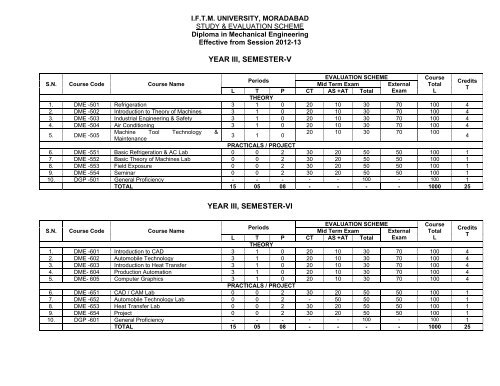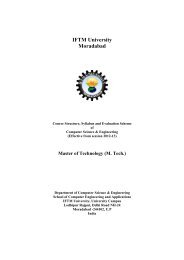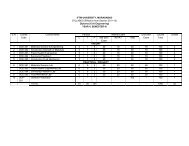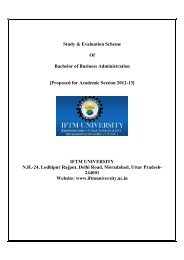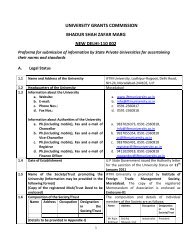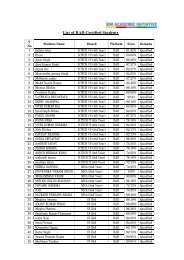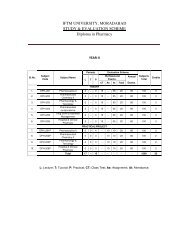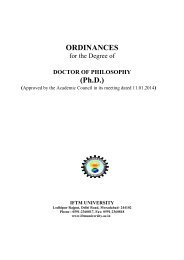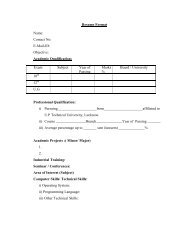Download - IFTM University
Download - IFTM University
Download - IFTM University
You also want an ePaper? Increase the reach of your titles
YUMPU automatically turns print PDFs into web optimized ePapers that Google loves.
I.F.T.M. UNIVERSITY, MORADABADSTUDY & EVALUATION SCHEMEDiploma in Mechanical EngineeringEffective from Session 2012-13YEAR III, SEMESTER-VS.N. Course Code Course NameEVALUATION SCHEMECoursePeriodsCreditsMid Term ExamExternal TotalTL T P CT AS +AT Total Exam LTHEORY1. DME -501 Refrigeration 3 1 0 20 10 30 70 100 42. DME -502 Introduction to Theory of Machines 3 1 0 20 10 30 70 100 43. DME -503 Industrial Engineering & Safety 3 1 0 20 10 30 70 100 44. DME -504 Air Conditioning 3 1 0 20 10 30 70 100 45. DME -505Machine Tool Technology &Maintenance3 1 020 10 30 70 100PRACTICALS / PROJECT6. DME -551 Basic Refrigeration & AC Lab 0 0 2 30 20 50 50 100 17. DME -552 Basic Theory of Machines Lab 0 0 2 30 20 50 50 100 18. DME -553 Field Exposure 0 0 2 30 20 50 50 100 19. DME -554 Seminar 0 0 2 30 20 50 50 100 110. DGP -501 General Proficiency - - - - - 100 - 100 1TOTAL 15 05 08 - - - - 1000 254YEAR III, SEMESTER-VIS.N. Course Code Course NameEVALUATION SCHEMECoursePeriodsCreditsMid Term ExamExternal TotalTL T P CT AS +AT Total Exam LTHEORY1. DME -601 Introduction to CAD 3 1 0 20 10 30 70 100 42. DME -602 Automobile Technology 3 1 0 20 10 30 70 100 43. DME -603 Introduction to Heat Transfer 3 1 0 20 10 30 70 100 44. DME- 604 Production Automation 3 1 0 20 10 30 70 100 45. DME- 605 Computer Graphics 3 1 0 20 10 30 70 100 4PRACTICALS / PROJECT6. DME -651 CAD / CAM Lab 0 0 2 30 20 50 50 100 17. DME -652 Automobile Technology Lab 0 0 2 - 50 50 50 100 18. DME -653 Heat Transfer Lab 0 0 2 30 20 50 50 100 19. DME -654 Project 0 0 2 30 20 50 50 100 110. DGP -601 General Proficiency - - - - - 100 - 100 1TOTAL 15 05 08 - - - - 1000 25
I.F.T.M. UNIVERSITY, MORADABADSTUDY & EVALUATION SCHEMEDiploma in Mechanical EngineeringEffective from Session 2012-13DME – 501: Refrigeration L T P 3 1 0UNIT 1. REFRIGERATION: Its meaning and application, Unit of refrigeration, various methods of refrigeration.ABSORPTION REFERIGERATION: Basic system, Ammonia system, improved absorption system, Electrolux refrigerator. Simple problems onbasic and improved system.UNIT 2. VAPOUR COMPRESSION SYSTEM: Simple saturated vapor compression cycle, Standard vapor compression cycle, Study of P-h chartand T-S chart, Numerical analysis of vapor compression cycle with P-h and T-S chart, Wet and dry compression, Factor effects the COP ofsystem, Departure of actual vapor compression cycle from Theoretical cycle of vapor compression, By passing of evaporator, Flash chamber,Accumulator, Pre cooler and Sub cooler, System modification by multi compression and expression, System modification by compoundcompression with inter cooling, Dual and multi effect compression, Multi load system of refrigeration.AIR CYCLE REFERIGERATION: Ideal air cycle, boot strap system, application. Revered carnot cycle, Bell coleman cycle. Simple numericalproblems.UNIT 3. COMPRESSORS: Introduction types and classification of compressors.(a) RECIPROCATING COMPRESSORS: Construction and arrangement of cylinders, types and construction of piston, Suction and dischargevalve (types and construction), Poppet valves, ring plate valves, flexing valves, valve location, Bore and stroke relation of a compressor.Construction of cranks, connecting rod, crank shaft seal and gaskets, lubricants, their properties, Lubrication recommendations (Small systems,industrial refrigeration, miscellaneous equipment) methods of lubrication, Liquid refrigerant in compressor crank case. Method of reducing oilfoaming at the compressor start.(b) ROTARY COMPRESSORS: Construction and working, cylinder construction and fitting rotar construction, blade construction, crank shaftconstruction, valve construction, crank shaft seal and gaskets. Lubrication of rotary compressors.(c) CENTRIFUGAL COMPRESSORS: Construction and working of compressor, sealed unit rufflers and their advantages, hermatic rotarycompressors, Regulation of compressor capacity, Starting of compressor, shutting down of a compressor.UNIT 4. CONDENSORS:Definition, type of condensers, air cooled, water cooled and evaporator type. Air cooled condensers- Natural convection, Mechanically cooledfinned tube, Plate type, Wire mesh, induced and forced type, Chesis mounted and remote type, air quantity and velocity for an air cooledcondenser and rating and selection of air cooled condensers. Water cooled condensers, Evaporative condensers.UNIT 5. EVAPORATORS AND COOLERS: Definition, design, over all heat transfer co-efficient, L.M.T.D., Evaporator T.D., Effect of evaporatorT.D. on space humidity, other factors of evaporator selection. Types of evaporators, Flooded and dry expansion evaporators. Classificationaccording to type of construction, Bare tube, Plate surface and finned, Natural convection evaporators. Rating and selection of natural convectionevaporators. Forced Convection evaporators rating and selection of unit coolers, liquid chilling evaporators (Chillers), double pipe coolers,advantage, disadvantage, application.Books:1. Refrigeration and Air conditioning, by Manohar Prasad, New Age International (P) Ltd.Pub.2. Refrigeration and Air conditioning by C.P Arora.3. Refrigeration and Air conditioning by Arora & Domkundwar.4. Refrigeration and Air conditioning by stoecker & Jones.5. Refrigeration and Air conditioning by Roy J. Dossat.
I.F.T.M. UNIVERSITY, MORADABADSTUDY & EVALUATION SCHEMEDiploma in Mechanical EngineeringEffective from Session 2012-13DME – 502: Introduction to Theory of Machines L T P 3 1 0UNIT 1. MECHANISMS AND MACHINES: Definition, Kinematic pairs, types of mechanism, Special types of mechanism, Space mechanisms.KINEMATIC ANALYSIS & SYNTHESIS: Displacement, Velocity and Acceleration of plane mechanism, Graphical and analytical techniques,Synthesis of mechanisms - Crank Rockers, Four Bar Mechanisms, Slider Crank Mechanisms.UNIT 2. DYNAMICS OF MACHINES: Static and dynamic force analysis, Graphical and analytical approaches, Engine mechanisms, Turningmoment diagram, Flywheel analysis, Gyroscopic action in machines.GOVERNORS: Types and classification, Principle of working of gravity controlled and spring controlled governors, Stability, Isochronisms,Sensitivity and capacity.UNIT 3. UNBALANCE IN MACHINES, ENGINES AND BALANCING: Origin of unbalanced forces and moments and effects of unbalance,Unbalance n rotating bodies and balancing of discs and rotors, Balancing machines, Field balancing of discs and rotors, Unbalance inreciprocating machines -engine, Compressor, Presses. Unbalance force and moment in a single cylinder engine and balancing, Multi cylinderengine balancing in Line engine, V and Radial engines, Lanchestor balancing techniques.UNIT 4. CAMS AND CAM FOLLOWER MECHANISMS: Purpose of using cam- Follower mechanisms, types of cams and cam followermechanisms, Nomenclature synthesis of disc cam profiles for prescribed follower motion, determination of basic dimension, Graphical andanalytical approaches for different types of followers, Dynamics of cam – follower systems - Jump and crossover stock.UNIT 5. GEARS AND GEAR DRIVES: Power transmission by gears and fundamental law of gearing, Involutes profile and conjugate action,Characteristics of involute tooth gear - Pinon to system, Under cutting and interference, Minimum number teeth, types of gears, Various geardrives - Spur, Helical, worm and Bevel gear, Gear train - Simple compound and epicycle gear trains, Differential gears.VIBRATION: Vibration of single degree of freedom, Systems, Free forced, Damped and undamped vibration, Frequency response andresonance, Bare excitation - Transmissibility and Isolation, Free vibration 2 DOF system - Concept of normal mode, vibration absorber,Multidegree of freedom systems, Free vibration of bars, Shafts and beams, Energy methods and approximate methods.Books1. Theory of Machines - Thomas Bevan2. Theory of Machines and Mechanisms- Shigley3. Theory of Machines and Mechanisms-Ghosh & Mallik4. Theory of Machines and Mechanisms- Rao & Dukkipati5. Theory of Machines-S.S. Rattan6. Kinematics of Machines-Dr. Sadhu singh7. Mechanics of Machines . V. Ramamurti8. Theory of Machines . Khurmi & Gupta9. Theory of Machines . R. K. Bansal10. Theory of Machines . V. P. Singh
I.F.T.M. UNIVERSITY, MORADABADSTUDY & EVALUATION SCHEMEDiploma in Mechanical EngineeringEffective from Session 2012-13DME – 503: Industrial Engineering & Safety L T P 3 1 0UNIT 1. INSPECTION: Inspection, Need and its planning, objective. Types of inspection. Inspection standards. Duties of inspector in inspection.Inspection needs.WORK STUDY: Method Study-Process chart, Flow process chart, Flow diagram, Man and Machine chart, Gang process Chart. WorkMeasurement-Time study, Tools used in time study, Performance rating, Allowance and use of time standard, Time and Motion study. Principle ofhuman motion economy, Micromotion study, Memomotion study, Therbligs, left hand and right hand chart.UNIT 2. PRODUCTION, PLANNING AND CONTROL: Methods of production-Unit, Batch, mass. Sales forecasting and its use. Planning-Products, process parts, materials, Optimum Batch quantity for production and Inventory, Theory and Analysis of M/C capacity, Batch quantity,Loading and Balancing-Scheduling M/C loading. Preplanning activities, Routing, Dispatching, Follow up activities.UNIT 3. MATERIAL HANDLING AND MATERIAL HANDLING EQUIPMENT: Factors in material handling problems, Cost reduction throughimproved material handling, Reduction in time of material handling, Material handling equipments –Lifting lowering devices, Transporting devices,Combination devices, Maintenance of material handling equipments.UNIT 4. PLANT LAYOUT: General plant location factors, Influence of location on plant layout, selection of plant site, Product layout, Processlayout. Advantages and disadvantage of process layout.QUALITY CONTROL: Concept of quality control, Quality assurance elements of quality control, Statistical quality control, Acceptance sampling,control chart for variable and attributes, Uses of X, R, "P" and "C" chart - O.C. curve, Concept of Total Quality ManagementUNIT 5. COST ESTIMATION: Introduction and function of cost estimation, estimation procedure, elements of cost, depreciation - methods ofcalculating depreciation, overhead expenses, distribution of over head expenses, calculation of cost for machining and metal forming process andbreak even analyzer.ACCIDENTS AND SAFETY: Classification of accidents, causes of accidents, Effects of accidents, Action to be taken in case different types ofAccidents, Safety - needs, consciousness, procedures, measures. General safety devices used on machines, Safe working condition andproductivity.BooksIndustrial Management by M.Mahajan
I.F.T.M. UNIVERSITY, MORADABADSTUDY & EVALUATION SCHEMEDiploma in Mechanical EngineeringEffective from Session 2012-13DME – 504: Air Conditioning L T P 3 1 0UNIT 1. PSYCHOMETRY: Definition, composition of air, Daltons Law of partial pressure, Gas and vapor mixture, Dry and wet bulb temperature,Wet bulb depression, Dew point, Dew point depression, Saturated air, Humidity (Specific humidity, Absolute humidity, Degree saturated, Relativehumidity), Humid specific volume and Humid specific heat, Enthalpy of moist air, Study and use of Psychometric chart and tables.Psychometric Process and Their Methods: Sensible heating and cooling, Adiabatic cooling, Humidification and Dehumidification, Cooling andHumidification, Cooling and Dehumidification, Heating and Humidification, Heat and Dehumidification, Humidification Efficiency.UNIT 2. COMFORT AIRCONDITIONING: Fundamentals of comfort conditioning, Thermodynamics of a human body, Comfort chart, Effectivetemperature, Factors governing optimum, Effective temperature, Economic consideration for selecting the comfort point, comfort air conditionsrecommended far inside design conditions for air conditioning.AIRCONDITIONING LOAD CALCULATIONS:A. COLLING LOAD CALCULATIONS: Design conditions for cooling space, sensible heat gains in the space – (i) Heat transmission load throughbuilding structure in through wall door and windows, Roof and Floor, (ii) Solar radiation heat lock (iii) Infiltration heat load (iv) Occupants heat load(v) Electric appliances heat load (vi) Product cooling load above freezing and below freezing (vii) Outside ventilation air load (viii) Other internalheat sources. (ix). Miscellaneous items for latent heat load.B. HEATING LOAD CALCULATIONS: Sensible heat loss- (i) Heat Transmission loss through building structure (ii) Infiltration heat loss (iii)Product heat loss (iv) Other materials heat loss. Latent Heat loss - (i) Infiltration heat loss (ii) Miscellaneous items for latent heat loss. Auxiliaryheat source, Net heating capacity, intermittently heat building.UNIT 3. AIR CONDITIONING SYSTEM: 1. Unit air-conditioning system (Window air conditioning system), Remote and split air conditioners.2. Package air conditioning system i. Package A.C. with water cooled condenser ii. Package A.C. with air cooled condenser.3. Central Air conditioning system i. D.X system with air handling unit ii. Chilled and Hot water system with fan coil unit.HEAT RECOVERY SYSTEM AND HEAT PUMP: Heat recovery with parallel condensers. Heat well, Basic principle of heat pump, Heat sourceand sink. Application of heat pump, co-efficient of performance of heat.UNIT 4. FLUID FLOW, DUCT DESIGN AND AIR DISTRIBUTION SYSTEM: Pressure drop through duct, conversion from circular section torectangular section duct design - Equal friction loss (Pressure drop) method, The Static Regain Method, Velocity Reduction Method, Advantagesand disadvantages of the above methods. AIR DISTRIBUTION SYSTEM: Duct System - the perimeter system, EXTENDED PLENUM SYSTEM:Different methods of air distribution.UNIT 5. AIR CONDITIONING EQUIPMENTS: Air contaminants, Purpose and methods of air cleaning, Different types of air filters and humidifiers,Fans and Blowers, grills and registers. AIR FILTERS, HUMIDIFIERS, FAN AND BLOWERS: (i) Axial flow (ii) Radial flow.EVAPORATICE COOLING: Evaporative cooling - Thermodynamics of evaporative cooling, Types of evaporative coolers - Spray type, Pad type,Rotating type, Efficiency of evaporative cooling, Limitation of evaporative cooling, Indirect or, Modified evaporative cooling system.Books:1. Refrigeration and Air conditioning, by Manohar Prasad, New Age International (P) Ltd.Pub.2. Refrigeration and Air conditioning by C.P Arora.3. Refrigeration and Air conditioning by Arora & Domkundwar.4. Refrigeration and Air conditioning by stoecker & Jones.5. Refrigeration and Air conditioning by Roy J. Dossat.6. Refrigeration and Air conditioning by P.L. Baloney.
I.F.T.M. UNIVERSITY, MORADABADSTUDY & EVALUATION SCHEMEDiploma in Mechanical EngineeringEffective from Session 2012-13DME – 505: Machine Tool Technology & Maintenance L T P 3 1 0UNIT 1. BASIC FEATURES AND KINEMATICS: Various types of machining operations and machine tools. Common features of all basicmachine tools, work holding and tool holding devices, Drive systems, sources of power, Bed, body or frame. Mechanical drive system for providingreciprocating, oscillating and rotational movement. Systems of stepped and step less, friction and positive drives. Principle of setting upper, Lowerand Intermediate speeds. Mechanical methods of providing automaticity in machine tools.UNIT 2. CENTRE LATHE: The centre lathe and its principle of working. Types of lathes, Lathe specification and size, Features of lathe bed. Headstock and tail stock. Feed mechanism and change-gears, carriage saddle, Cross slide, Compound rest, Tools post, Apron mechanism, latheaccessories, Chucks, Face plate, Angle plate, Driving plate, Lathe dogs, mandrills, Steady rest, Lathe attachments. Lathe operations-plane andstep turning, Taper turning, Screw cutting, Drilling, Boring, reaming, Knurling, Parting off, Under cutting, Relieving. Types of lathe tools and theiruses. Brief description of semi automatic and automatic lathes such as capstan and turret lathes, their advantages and disadvantages over centrelathe, types of job done on them. General and periodic maintenance of a centre lathe.UNIT 3. SHAPING, PLANING & SLOTTING MACHINES: Working principles of planer, shaper and slotter. Differences and similarities amongthem, quick return mechanism applied to the machines. Types of work done on them, types of tools used their geometry. General and periodicmaintenance of a shaper.DRILLING & BORING MACHINES: Types of tools used in drilling and boring. Classification of drilling and boring machines, principle of workingand constructional details of simple and radial drilling M/C and general and periodic maintenance. Operations like facing, counter boring, tapering.UNIT 4. MILLING MACHINES: Types of milling machines, constructional features of horizontal milling M/C. general maintenance of the machine,types of milling cutters, milling operations like plane milling, space milling, angular milling form milling, straddle milling, gang milling, Negative rackmilling, cutting speed and speed for different tools in up and down milling. Simple compound and differential indexing, milling of spur gears andracks. General and periodic maintenance of milling machine.UNIT 5. JIGS AND FIXTURES: Object of Jigs and Fixture. Difference between jigs and fixtures. Principle of location. Principle of clamping.Locating and clamping devices. Types of jigs -Simple open and closed (or box) jigs. Drill jigs- Bushes (Fixed liner, Renewal slip). Template. Platejigs. Channel jigs, Leaf jigs. Simple example of milling, turning, grinding, horizontal boring fixtures and broaching fixtures. Welding fixtures,devices.COOLING PROCESS: Coolants and cutting fluids difference between coolant and cutting fluid, Function and action of cutting fluids. Requirementof good cutting fluids, their selection for different materials and operations.Books :1. Machine Tools Design & Numerical Controls .N.K. Mehta, T.M.H. New Delhi.2. Design of Machine Tools . S.K. Basu Allied Publishers.3. Principles of Machine Tools, Bhattacharya A and Sen.G.C. New Central BookAgency.
I.F.T.M. UNIVERSITY, MORADABADSTUDY & EVALUATION SCHEMEDiploma in Mechanical EngineeringEffective from Session 2012-13DME – 551: Basic Refrigeration & AC Lab L T P 0 0 2List of Experiments: Say minimum 08 experiments out of the following:1. Study and use of different refrigeration tools and equipments.2. Practice in cutting, Bending, Flaring, Soldering and Brazing, soldering of copper tubes.3. Study of open type reciprocating compressor used in a refrigeration system.4. To determine the capacity for window type air conditioner5 Proper methods of setting and adjustingi. thermostatii. Low pressure and high pressure cutoutiii. Thermostat expersion ball6. Wiring of refrigerator, water cooler, desert cooler, room air conditioner, packed air conditioner, panel board.7. Study of a reciprocating Hermetically Sealed Compressor.8. Study of electric controls such as - Over Lead Protector, Starting Relay, Potential Relay, and thermostat, Solenoid Valve, Humidistat, HighPressure Control and Low Pressure Control.9. Heat testing, Evacuation, Dehydration and Charging of a Refrigerating machine (Sealed Unit and Open Unit).10. Study of Refrigerator (Vapor compression and Vapor absorption type).11. Study of water cooler and calculation of water cooling rate.12. Study of different refrigerant flow controls.13. Study of refrigeration trainer and determine its C.O.P.14. To find out air properties such as Dry Bulb Temperature, Wet Bulb Temperature, D. P. T., Relative Humidity, Specific Humidity, SpecificVolume and Enthalpy of air with the half of sling Psychrometer and Psychometric chart and compare the results thus obtained.15. Study of window type air conditioner.16. To find out bypass factor of cooling coil, heating coil.17. Study of desert cooler and find out its humidifying or cooling efficiency.18. Study of air-conditioning trainer and find out its C.O.P.
I.F.T.M. UNIVERSITY, MORADABADSTUDY & EVALUATION SCHEMEDiploma in Mechanical EngineeringEffective from Session 2012-13List of Experiments: Say minimum 08 experiments out of the following:1. Study of simple linkers/models/mechanisms.2. Exp. on Velocity acceleration.3. Exp. on cam.4. Exp. on Governor.5. Exp. on critical speed of shaft (whirling of shaft)6. Exp. on Gyroscope7. Exp. on Balancing (static & dynamic)8. Exp. on 4-bar mechanism9. Exp. on Gears (tooth profile, interference etc.)10. Exp. on Gear trains.11. Exp. on Brakes12. Exp. on clutch13. Exp. on synthesis of planner linkages14. Exp. on Mechanism15. Exp. on Vibration (spring)16. Exp. on Vibration (beam)17. Exp. on Vibration (Torsional)18. Exp. on EngineDME – 552: Basic Theory of Machines Lab L T P 0 0 2


